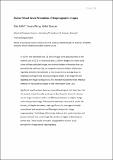Human visual based perception of steganographic images
Abstract
In 2014 it was estimated that 1.8 billion images were uploaded daily to the Internet, and in 2018 it is estimated that 3.2 billion images are shared daily. Some of these uploaded images may contain hidden information that can potentially be malicious (e.g. an image that contains hidden information regarding terrorism recruitment) or may cause serious damage (e.g. an employee wishing to hide sensitive company details in an image file and exporting the image to third parties). This research studied the most effective methods in manipulating images to hide information (Data Loss). Significant work has been done on computational algorithmic detection. Yet the desired output from this work was to find the point at which a human can no longer visually establish the difference between an original image and a manipulated image. This research examines the extent of use for file formats, bit depth alterations, least significant bits, message and audio concealment and watermark and filtering techniques for image steganography. The findings of this study indicated that audio insertion and picture insertion into cover image files are the strongest in deceiving the human eye. These results have been categorised for human visual perception in image-based steganography.
Citation
Fyffe , B , Wang , Y & Duncan , I M M 2019 , ' Human visual based perception of steganographic images ' , Journal of Cyber Security Technology , vol. 3 , no. 2 , pp. 61-107 . https://doi.org/10.1080/23742917.2019.1609393 , https://doi.org/10.1080/23742917.2019.1609393
Publication
Journal of Cyber Security Technology
Status
Peer reviewed
ISSN
2374-2917Type
Journal article
Collections
Items in the St Andrews Research Repository are protected by copyright, with all rights reserved, unless otherwise indicated.

